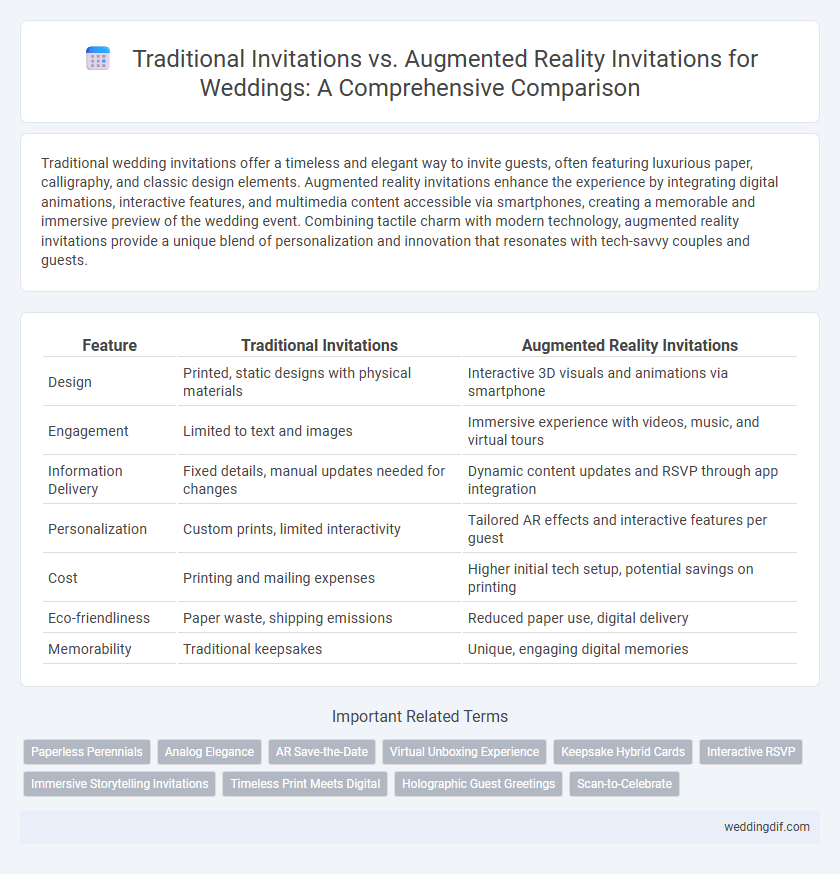Traditional wedding invitations offer a timeless and elegant way to invite guests, often featuring luxurious paper, calligraphy, and classic design elements. Augmented reality invitations enhance the experience by integrating digital animations, interactive features, and multimedia content accessible via smartphones, creating a memorable and immersive preview of the wedding event. Combining tactile charm with modern technology, augmented reality invitations provide a unique blend of personalization and innovation that resonates with tech-savvy couples and guests.
Table of Comparison
| Feature | Traditional Invitations | Augmented Reality Invitations |
|---|---|---|
| Design | Printed, static designs with physical materials | Interactive 3D visuals and animations via smartphone |
| Engagement | Limited to text and images | Immersive experience with videos, music, and virtual tours |
| Information Delivery | Fixed details, manual updates needed for changes | Dynamic content updates and RSVP through app integration |
| Personalization | Custom prints, limited interactivity | Tailored AR effects and interactive features per guest |
| Cost | Printing and mailing expenses | Higher initial tech setup, potential savings on printing |
| Eco-friendliness | Paper waste, shipping emissions | Reduced paper use, digital delivery |
| Memorability | Traditional keepsakes | Unique, engaging digital memories |
Introduction: The Evolution of Wedding Invitations
Wedding invitations have evolved from classic engraved cards to immersive augmented reality experiences that blend tradition with innovation. Traditional invitations emphasize timeless elegance and tactile quality, while augmented reality invitations offer dynamic visual storytelling and interactive features. This shift reflects changing preferences, enhancing guest engagement and personalization in modern wedding celebrations.
What Are Traditional Wedding Invitations?
Traditional wedding invitations typically consist of printed cards featuring elegant typography, classic design elements, and formal wording to convey essential details like the date, time, and venue. These invitations often use high-quality paper and envelopes, reflecting cultural customs and personal tastes while serving as keepsakes for guests. Their tangible nature offers a timeless and personal touch, contrasting with the interactive and multimedia features of augmented reality invitations.
Exploring Augmented Reality (AR) Wedding Invitations
Augmented Reality (AR) wedding invitations provide immersive and interactive experiences that traditional paper invitations cannot match, allowing guests to view 3D animations and personalized messages through their smartphones. By integrating multimedia elements, AR invitations enhance guest engagement and offer unique ways to convey wedding details and venue visuals. This innovative approach not only modernizes the invitation process but also creates memorable keepsakes that blend technology with celebration.
Design and Aesthetics: Classic vs. Digital Innovation
Traditional wedding invitations emphasize elegant paper textures, intricate calligraphy, and timeless design elements that convey a sense of formality and heritage. Augmented reality invitations incorporate digital innovation by blending physical cards with interactive 3D visuals, animations, and personalized multimedia experiences that enhance guest engagement. This fusion of classic aesthetics with cutting-edge technology creates a unique and memorable design that redefines traditional wedding invitation standards.
Guest Experience: Tangibility vs. Immersive Interaction
Traditional wedding invitations offer a tangible keepsake that guests can physically hold, enhancing a sense of personal connection and nostalgia. Augmented reality invitations elevate guest experience through immersive interaction, allowing recipients to engage with dynamic visuals and personalized multimedia content via smartphones. This fusion of physical and digital elements transforms the invitation from a static artifact into an interactive storytelling medium, increasing guest engagement and anticipation.
Personalization Options in Traditional and AR Invitations
Traditional wedding invitations offer classic personalization through elegant typography, embossed details, and custom monograms, allowing couples to convey their unique style with tangible materials. Augmented reality (AR) invitations elevate personalization by integrating interactive elements such as 3D animations, video messages, and real-time RSVP features, creating an immersive experience for recipients. The fusion of traditional design aesthetics with AR technology enables highly customizable invitations that blend tactile elegance with dynamic digital content.
Cost Comparison: Printing vs. Digital Deployment
Traditional wedding invitations typically incur significant printing and material costs, averaging between $2 to $5 per card depending on design complexity and paper quality. Augmented reality (AR) invitations reduce expenses by eliminating physical printing, relying instead on digital deployment through apps or QR codes, which can cost as low as $0.50 per invite for platform fees and digital assets. Digital AR invites also offer scalability without proportional cost increases, making them more cost-effective for large guest lists compared to traditional printing expenses.
Eco-Friendliness: Paper Waste vs. Digital Footprint
Traditional wedding invitations often generate significant paper waste, contributing to deforestation and landfill accumulation, while augmented reality invitations minimize environmental impact by reducing the need for physical materials. Digital invitations rely on data centers and internet usage, which have their own carbon footprint, but overall they offer a more sustainable alternative by eliminating excess paper and printing resources. Choosing augmented reality invitations supports eco-conscious couples aiming to enhance guest engagement without compromising environmental responsibility.
Accessibility and Technological Barriers
Traditional wedding invitations offer simplicity and universal accessibility, requiring no special technology or digital literacy, making them suitable for all age groups and socioeconomic backgrounds. Augmented reality invitations, while innovative and engaging, face technological barriers such as the need for compatible smartphones, reliable internet access, and user familiarity with AR apps, potentially limiting accessibility for less tech-savvy or resource-constrained guests. Balancing these factors is crucial when choosing between classic paper invites and AR-enhanced designs to ensure inclusivity and seamless guest experience.
Which Invitation Type Suits Your Wedding Style?
Traditional invitations offer a timeless elegance with tactile materials like embossed paper and calligraphy, perfect for classic or vintage-themed weddings that emphasize formality and tradition. Augmented reality invitations enhance guest engagement through interactive digital elements such as videos and 3D animations, ideal for modern couples seeking a tech-savvy and immersive experience. Choosing between these options depends on your wedding style, whether you prioritize a nostalgic aesthetic or innovative storytelling to set the tone for your celebration.
Traditional invitations vs augmented reality invitations for weddings. Infographic

 weddingdif.com
weddingdif.com